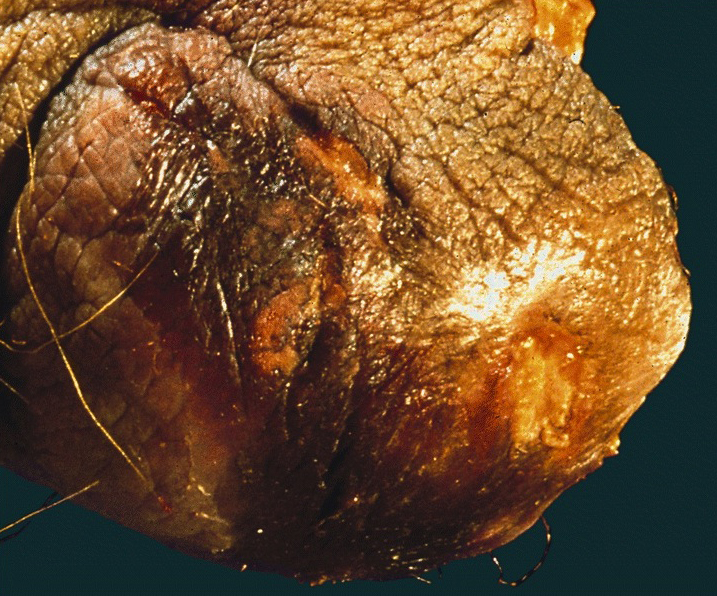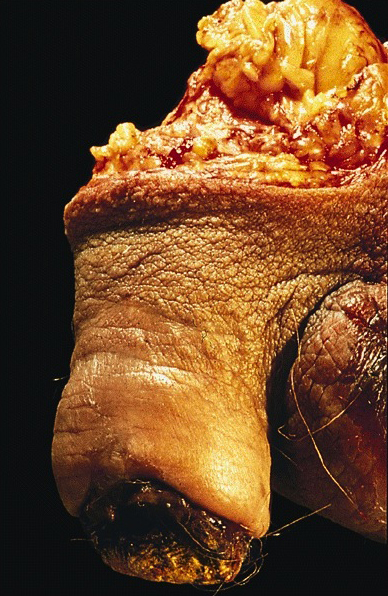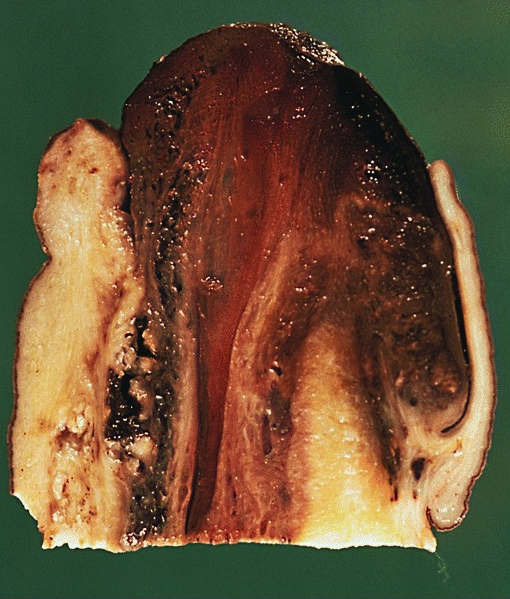Table of Contents
Definition / general | Epidemiology | Sites | Etiology | Diagrams / tables | Clinical features | Prognostic factors | Case reports | Treatment | Clinical images | Gross images | Microscopic (histologic) description | Microscopic (histologic) images | Differential diagnosisCite this page: Chaux A, Cubilla AL. Fournier gangrene. PathologyOutlines.com website. https://www.pathologyoutlines.com/topic/penscrotumfournier.html. Accessed April 27th, 2024.
Definition / general
- First documented in 1883 by Professor Jean Alfred Fournier (Whonamedit: Fournier Gangrene [Accessed 28 March 2018], eMedicine: Fournier Gangrene [Accessed 28 March 2018])
- Serious life threatening condition characterized by necrotizing fasciitis of genitalia and perineum
- Risk factors: trauma, burns, anorectal disease, diabetes, leukemia and alcoholic cirrhosis
Epidemiology
- Elderly adults (male and female), immunocompromised (particularly diabetes) or those with depressed mental status
Sites
- Dartos and penile fascia are preferred sites
Etiology
- 50 - 60% of infections have GI or GU source of infection
- Usually a polymicrobial infection
- Streptococcus and Staphylococcus most common in children
- Gram negative bacilli and anaerobic bacteria most common in adults
- Source of infection may be colorectal, urologic or cutaneous
- Infection spreads from skin down fascial plane, causing inflammation, ischemia and necrosis; low oxygen tension and necrosis promote anaerobes and cause rapid dissemination
- Obliterative endarteritis plays a key role in pathogenesis
Clinical features
- Patients present with genital induration, pain, erythema and crepitus
- Xrays may show air in perineal tissue
- To diagnose, MUST examine genitals, particularly in elderly or patients with diminished mental status
- Finding nidus of infection is important - may be periurethral or perirectal
- History of perineal trauma is important
- Affects Buck fascia and foreskin, sparing glans
- Mortality rate of 7 - 22%, even with timely and aggressive therapy (J Urol 2009;181:2120)
Prognostic factors
- Fournier gangrene severity index (FGSI) scores > 9 predicts severity and mortality (J Urol 1995;154:89, J Postgrad Med 2008;54:102)
- FGSI: nine variables are assigned scores of 0 - 4, which are added together
- Variables are body temperature, heart rate, respiratory rate, serum sodium, serum potassium, serum creatinine, hematocrit and white blood count and serum bicarbonate (see table above)
- Cirrhosis, not a FGSI factor, is also a poor prognostic factor (J Microbiol Immunol Infect 2007;40:500)
Case reports
- 50 year old man with blackened skin on penis and scrotum (Internet Journal of Emergency Medicine 2008;5(1))
- 65 year old man with third degree burns (J Med Case Rep 2009;3:7264)
Treatment
- Aggressive medical treatment (fluids, broad spectrum antibiotics) plus aggressive surgical debridement with aggressive wound care
- Skin grafts are usually not required due to elasticity of genital skin (West J Emerg Med 2009;10:281)
- Hyperbaric oxygen does not appear to be useful
Clinical images
Gross images
Microscopic (histologic) description
- Penile fascia with severe inflammation (neutrophils), bacteria and necrotic tissue
- Thrombosis of small vessels (obliterative endarteritis)
- Deep erectile tissue usually remains unaffected
Microscopic (histologic) images
Differential diagnosis
- Corbus disease (gangrenous balanitis):
- Similar to Fournier gangrene, affects exclusively glans penis and foreskin is usually spared












